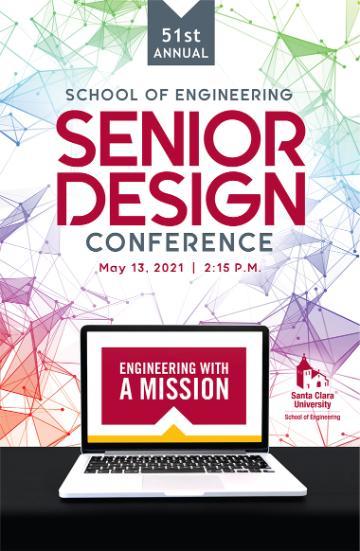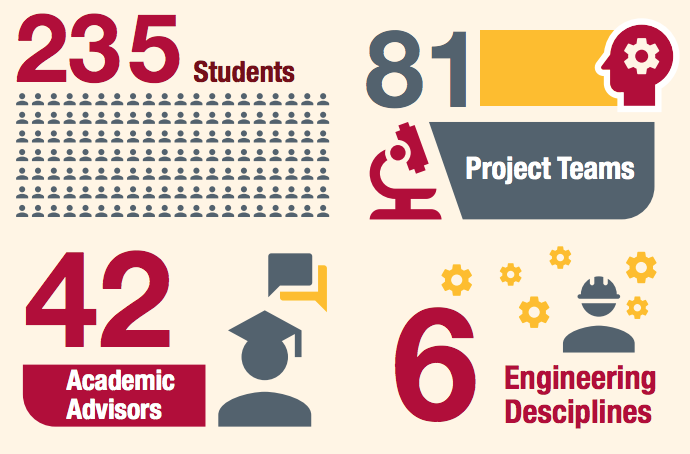
Senior Design Snapshot
With more than 80 teams from 6 engineering disciplines presenting in this year’s Senior Design Conference, the range of projects runs the gamut from biowearables to agribots, and from safe drinking water to cybersecurity. In this year when wildfires, virtual healthcare, and media misinformation became daily concerns, our students turned their time and talents to solving these and so many more challenges. Here are a few examples, but you may find the full list of projects in the 2021 Senior Design Preliminary Schedule.
Bioengineering:
Encellin Therapeutic Implant Delivery System
John DePalo, James, Peterman, Isabelle Vidamo
Advisors: Ashley Kim, Verna Rodriguez
Working with Encellin, a local startup focusing on a preventive approach to managing Type 1 Diabetes, this team is developing a minimally invasive insertion tool for implanting and maintaining the integrity of the company’s device at a standard subcutaneous depth in a patient’s forearm.
Civil, Environmental, and Sustainable Engineering:
Water Treatment Solutions for Wildfire Impacted Watersheds
Michael Reyes, Jackson Shank, Mai Sinada, David Villani
Advisor: Aria Amirbahman
In watersheds affected by wildfires, contaminants are delivered to water treatment plants or supply reservoirs at extreme and unmanageable concentrations. To assist treatment plants in St. Helena, California, this team proposed solutions targeting the removal of sediments, increased nitrates, and fire-retardant chemicals from runoff.
Computer Science and Engineering:
Alzheimer’s Disease Diagnostic Support Tool
Chelsea Fernandes, Aiyushi Kumar, Shreya Venkatesh
Advisors: Ahmed Amer, Julia Scott (BioInnovation and Design Lab)
This project aims to develop a web-based diagnostic support tool physicians can use in a clinical setting to increase the efficiency and accuracy of diagnosing Alzheimer’s Disease. Their solution uses a machine learning model to classify patients into one of three possible stages of Alzheimer's Disease using multiple clinical parameters.
Electrical and Computer Engineering:
Telehealth Sensor Authentication Through Memory Chip Variability
Gordon Holden, Calvin Kimbro, Thomas Lyp
Advisor: Fatemeh Tehranipoor
As the world of remote patient monitoring grows, so too does the threat of malicious third parties abusing remote sensor security vulnerabilities. The focus of our research is to find hardware components and processes that can be used for security purposes. The research is especially applicable for remote sensors and IoT devices.
General Engineering:
Dynamic Solar Shading System
Walker Battey, Alexander Kravtsov
Advisor: Jes Kuczenski
This team is creating a Dynamic Solar Shading mechanism for SCU’s Kids on Campus daycare playground to reduce the exposure of dangerous UV-light on children’s skin. The solar-powered system is designed to be fully-automated and virtually maintenance cost-free.
Interdisciplinary Engineering:
Adaptive Robotic Chassis (ARC): RoboCrop A Smart Agricultural Robot Toolset
Brooke Broszus, Steven Bucher, Alejandro Gutierrez, Krissy Ikeda, Ariana Low
Advisor: Christopher Kitts
Addressing critical labor shortages in agriculture, the RoboCrop team is developing a modular system supporting agricultural tasks such as pruning strawberry flowers. This system is being integrated with an agricultural rover prototyped by a previous capstone team and being refined and fielded by a research team in the Robotics Systems Lab.
Mechanical Engineering:
The Drier Dryer
Daniel Anderson, Justin Lee, Thomas Morey, Josh Sunada
Advisor: Hohyun Lee
Increasing the efficiency of a dryer by removing moisture from the incoming air is the aim of this project. Minimizing the air’s relative humidity will maximize the amount of water that can be removed from clothes, thereby reducing the dryer’s operating time and increasing its efficiency.
